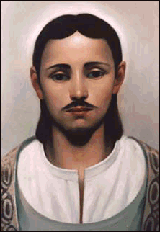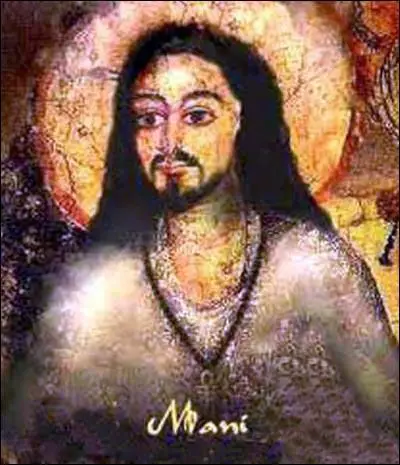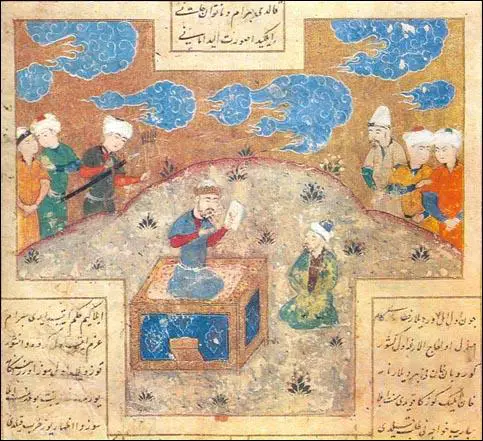Mani

Mani was born near Seleucia-Ctesiphon in about 209 AD. In one ancient document it is claimed that his mother was "named Meis or Utachin, or Mar Marjam (Sancta Maria) and that he was supernaturally born". (1) His father, Patek, had joined a religious community practicing baptism and abstinence. Through his mother Mani was related to the Parthian royal family. (2)
Mani was raised in a Jewish-Christian baptism sect. Manichaean writings indicate that Mani received revelations when he was 12 and again when he was 24, and over this time period he grew dissatisfied with the sect he was born into. "Mani did not entirely reject Christianity, but since he held that its teaching was only partially true, but supplemented it by borrowing from other religious and adding his own theories." (3)
Mani regarded himself as an apostle of God. According to the Encyclopædia Iranica: "His position (although not his lifestyle and biography) can be compared, rather, with that of Moḥammad in Islam. But Mani was highly praised as the founder of his church, the ultimate revealer of divine gnosis, and a model of righteous behavior, compassionate philanthropy, and brave martyrdom. He was also credited with supernatural healing power, clairvoyance, the gift of levitation, and with miraculous locomotion over considerable distances." (4)
Mani and Christianity
The religion that Mani founded has elements of the much older Persian creed of Zoroastrianism, which spoke of an eternal battle between good and evil. "The central doctrine of Manicheanism is that good and evil are two mighty forces engaged in a more or less evenly matched struggle. Practically everything in life can be seen as a manifestation of this battle. The realms of light and spirit, which are personified by a good God, wage war against the realms of darkness and matter, which are personified by a bad one. This evil God created the earth and entombed our souls, which are sparks of light, in the prisons of our bodies... It offered a straightforward answer to the puzzle of why God lets evil flourish, namely that He can do little about it because He is not quite the all-powerful being He is usually taken to be." (5)

The Manichees believed "the lower half of the body" as the disgusting work of the devil and "condemned meat-eating, and all sex, even in marriage". (6) Mani denied any authority to the Old Testament with its presupposition of the goodness of the material order of things. He much more preferred the New Testament but rejected orthodox Christianity for being too exclusive and negative towards other religious myths and forms of worship. He understood Jesus as a symbol of the plight of all humanity rather than as a historical person. The "crucifixion was no kind of actuality but a mere symbol of the suffering which is the universal human condition." (7)
Mani's Philosophy
The religion of Mani's followers, included disgust at the physical world and especially at the human reproductive system. "Procreation imprisoned divine souls in matter, which is inherently hostile to goodness and light. Manichees had a vegetarian diet, and forbade wine. Melons and cucumbers were deemed to contain a particularly large ingredient of divinity. There were two classes, Elect who were strictly obliged to be celibate, and Hearers allowed wives or concubines as long as they avoided procreating children, whether by contraceptives or by confining intercourse to the 'safe' period of the monthly cycle.... Manichee propaganda was combative against the orthodox Catholic Church, which granted married Christians." (8)
The central question for Mani was the origin of evil. He explained evil as resulting from a primeval and still continuing cosmic conflict between Light and Dark. However, he gradually had doubts about the intellectual basis of the religion. Was Mani right when he asserted that the supremely good Light-power was weak and impotent in conflict with Dark? How could one properly worship a diety so powerless and humiliated? Mani also explained eclipses, by claiming that the sun and the moon were using special veils to shut out the distressing sight of cosmic battles. Augustine was aware that astronomers rejected this theory. Augustine also became disillusioned with the religion when he discovered that the moral life of the Elect, who argued for sinless perfection, turned out to be less celibate than they claimed. (9)

Mani traveled to India and made converts. On his return in 242, he joined the court of Shapur, the king of the Sasanian Empire, to whom he dedicated his only work written in Persian, known as the Shabuhragan. Shapur's successor Hormizd appears to have continued to patronize Mani, but his successor Bahram, a follower of the Zoroastrian reformer Kartir, began to persecute the Manichaeans. Mani told his disciples he was going to heaven, and would not return for a year. In 274 Mani was arrested and he was flayed alive and his skin stuffed with straw, was nailed to a cross and suspended over the main gate of the city of Gundeshapur as a warning to those who followed his teachings. "Thereupon most of his followers fled to India, and some even to China, those remaining being reduced to slavery." (10)
Primary Sources
(1) Anthony Gottlieb, The Dream of Reason: A History of Philosophy from the Greeks to the Renaissance (2000)
Mani, a Persian sage who regarded himself as an apostle of God, lived in southern Babylonia around the middle of the third century AD. The religion that he founded has elements of the much older Persian creed of Zoroastrianism, which spoke of an eternal battle between good and evil, and elements of Greek mystery-religions such as Orphism with their talk of purification and reincarnation. The central doctrine of Manicheanism is that good and evil are two mighty forces engaged in a more or less evenly matched struggle. Practically everything in life can be seen as a manifestation of this battle. The realms of light and spirit, which are personified by a good God, wage war against the realms of darkness and matter, which are personified by a bad one. This evil God created the earth and entombed our souls, which are sparks of light, in the prisons of our bodies... It offered a straightforward answer to the puzzle of why God lets evil flourish, namely that He can do little about it because He is not quite the all-powerful being He is usually taken to be.
Manicheanism was not - in theory, at any rate - a licence for debauchery. On the contrary it aimed for a purgation of the soul by an ascetic life, vegetarianism and abstention from sex. Reproduction was to be avoided because it enlarged the evil God's empire by producing yet more bodies. Followers of Mani were supposed to enlist on the side of goodness and light by suppressing their earthly appetites.
(2) Henry Chadwick, Saint Augustine: Confessions (2008)
Procreation imprisoned divine souls in matter, which is inherently hostile to goodness and light. Manichees had a vegetarian diet, and forbade wine. Melons and cucumbers were deemed to contain a particularly large ingredient of divinity. There were two classes, Elect who were strictly obliged to be celibate, and Hearers allowed wives or concubines as long as they avoided procreating children, whether by contraceptives or by confining intercourse to the 'safe' period of the monthly cycle.... Manichee propaganda was combative against the orthodox Catholic Church, which granted married Christians.
(3) Bertrand Russell, History of Western Philosophy (1946)
Manichaeism combined Christian and Zoroastrian elements, teaching that evil is a positive principle, embodied in matter, while the good principle is embodied in spirit. It condemned meat-eating, and all sex, even in marriage. Such intermediate doctrines helped much in the gradual conversion of cultivated men of Greek speech; but the New Testament warns true believers against them... Gnostics and Manichaeans continued to flourish until the government became Christian. pages 325-26
It is interesting that St Augustine's first reasons for rejecting the doctrines were scientific. He remembered - so he tells us - what he had learned of astronomy from the writings of the best astronomers, "and I compared them with the sayings of Mani, who in his crazy folly has written much and copiously upon these subjects; but none of his reasoning of the solstices, nor equinoxes, nor eclipses, nor whatever of this kind I had learned in books of secular philosophy, was satisfactory to me. But I was commanded to believe; and yet it corresponded not with reasonings obtained by calculations, and by my own observations, but was quite contrary." (Confessions Book V Chaper III). He is careful to point out that scientific mistakes are not in themselves a sign of errors as to the faith, but only became so when delievered with an air of authority as known through divine inspiration.
(4) John M. Robertson, Pagan Christs (1911) page 266
Mani is described as a painter, who set up a sectarian movement in opposition to Zoroastrianism, then in renewed favour in Persia, in the reign of Shapur I. Being proceeded against, he fled to Turkestan, where he made disciples and embellished with paintings a Tchighil (Chinese name for a temple or Picturarum Domus) and another temple called Ghalbita. Provisioning in advance a cave which had a spring, he told his disciples he was going to heaven, and would not return for a year, after which time they were to seek him in the cave in question. They then and there found him, whereupon he showed them an illustrated book, called Ergenk, or Estenk, which he said he had brought from heaven: whereafter he had many followers, with whom he returned to Persia at the death of Shapur. The new king, Hormisdas, joined and protected the sect; and built Mani a castle. The next king, Bahram or Varanes, at first favoured Mani; but, after getting him to debate with certain Zoroastrian teachers, caused him to be flayed alive, and the skin to be stuffed and hung up as alleged by the Christians. Thereupon most of his followers fled to India, and some even to China, those remaining being reduced to slavery.
In yet another Mohammedan account we have the details that Mani's mother was named Meis or Utachin, or Mar Marjam (Sancta Maria); and that he was supernaturally born. At the behest of an angel he began his public career, with two companions, at the age of twenty-four, on a Sunday, the first day of Nisan, when the sun was in Aries. He travelled for about forty years; wrote six books, and was raised to Paradise after being slain under Bahram "son of Shapur." Some say he was crucified "in two halves" and so hung up at two gates, afterwards called High-Mani and Low-Mani; others that he was imprisoned by Shapur and freed by Bahram; others that he died in prison. "But he was certainly crucified."
(5) Encyclopaedia Britannica (April, 2019)
Before Mani’s birth, his father, Patek, a native of Hamadan, had joined a religious community practicing baptism and abstinence. Through his mother Mani was related to the Parthian royal family (overthrown in 224). Information about his life appears to derive from his own writings and the traditions of his church. He grew up at his birthplace, speaking a form of eastern Aramaic. Twice, as a boy and young man, he saw in vision an angel, the “Twin,” who, the second time, called him to preach a new religion.
He traveled to India (probably Sind and Turan) and made converts. Favourably received on his return by the newly crowned Persian king, Shāpūr I, he was permitted to preach his religion in the Persian empire during that long reign. There is little information about Mani’s life in those years. He probably traveled widely in the western parts of the empire, but later traditions that he visited the northeast seem unsound. Under the reign of the Persian king Bahrām I, however, he was attacked by Zoroastrian priests and was imprisoned by the king at Gundeshapur (Belapet), where he died after undergoing a trial that lasted 26 days.
(6) Werner Sundermann, Encyclopædia Iranica (2009)
As the founder of the Manichean religion, Mani did not play the same role in the beliefs of his community as that of Jesus Christ in Christianity. He was not the only-begotten son of God, the divine sacrifice for the sake of mankind, the only revealer of the gospel of truth. His position (although not his lifestyle and biography) can be compared, rather, with that of Moḥammad in Islam. But Mani was highly praised as the founder of his church, the ultimate revealer of divine gnosis, and a model of righteous behavior, compassionate philanthropy, and brave martyrdom. He was also credited with supernatural healing power, clairvoyance, the gift of levitation, and with miraculous locomotion over considerable distances....
Being the central human subject of Manichean salvation history, Mani’s life necessarily underwent hagiographical stylization (and, equally, became the subject of hostile anti-legends) to such a degree that one may ask whether it is possible at all to sort out the essential historical facts from the legendary tradition. That is possible indeed, mainly because the development of the hagiographic stylization can sometimes be observed. Although it existed from the beginning as a self-stylization of the Apostle of Light, it became a perfect system only after Mani’s death. One can state as a rough rule: the older a hagiographic tradition on Mani’s life is, the greater is the chance that it also contains simple historical facts. It is the task of a critical analysis of our sources to try to establish a chronology (at least a relative one) of the sources and to find criteria for the historical or the legendary character of traditional dates.
Student Activities
References
(1) John M. Robertson, Pagan Christs (1911) page 266
(2) Encyclopaedia Britannica (April, 2019)
(3) R. S. Pine-Coffin, introduction to The Confessions (2002) page 13
(4) Werner Sundermann, Encyclopædia Iranica (2009)
(5) Anthony Gottlieb, The Dream of Reason: A History of Philosophy from the Greeks to the Renaissance (2000) page 379
(6) Bertrand Russell, History of Western Philosophy (1946) page 325
(7) Henry Chadwick, Augustine: A Very Short Introduction (2001) page 13
(8) Henry Chadwick, Saint Augustine: Confessions (2008) page xiv
(9) Henry Chadwick, Augustine: A Very Short Introduction (2001) page 15
(10) John M. Robertson, Pagan Christs (1911) page 266
